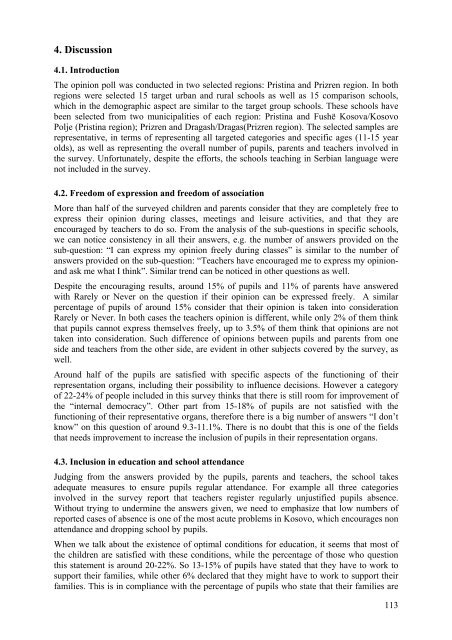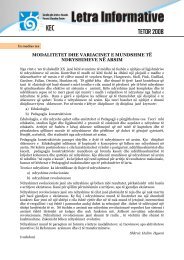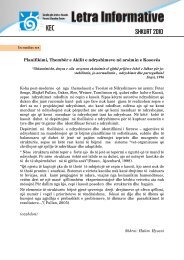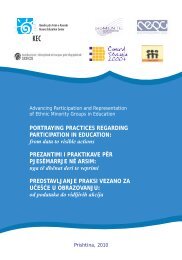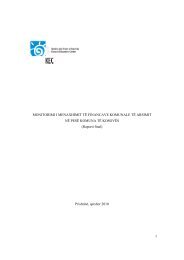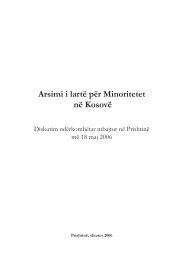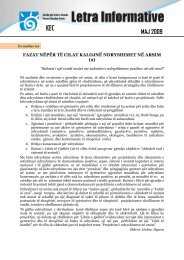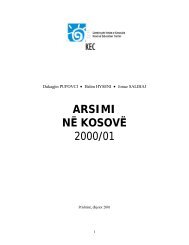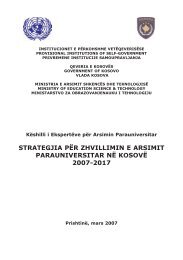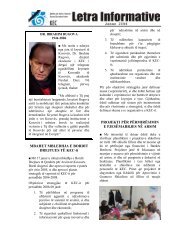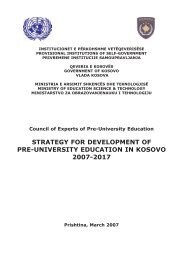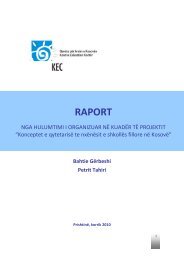Report of the situation of children's rights in the field of education
Report of the situation of children's rights in the field of education
Report of the situation of children's rights in the field of education
You also want an ePaper? Increase the reach of your titles
YUMPU automatically turns print PDFs into web optimized ePapers that Google loves.
4. Discussion4.1. IntroductionThe op<strong>in</strong>ion poll was conducted <strong>in</strong> two selected regions: Prist<strong>in</strong>a and Prizren region. In bothregions were selected 15 target urban and rural schools as well as 15 comparison schools,which <strong>in</strong> <strong>the</strong> demographic aspect are similar to <strong>the</strong> target group schools. These schools havebeen selected from two municipalities <strong>of</strong> each region: Prist<strong>in</strong>a and Fushë Kosova/KosovoPolje (Prist<strong>in</strong>a region); Prizren and Dragash/Dragas(Prizren region). The selected samples arerepresentative, <strong>in</strong> terms <strong>of</strong> represent<strong>in</strong>g all targeted categories and specific ages (11-15 yearolds), as well as represent<strong>in</strong>g <strong>the</strong> overall number <strong>of</strong> pupils, parents and teachers <strong>in</strong>volved <strong>in</strong><strong>the</strong> survey. Unfortunately, despite <strong>the</strong> efforts, <strong>the</strong> schools teach<strong>in</strong>g <strong>in</strong> Serbian language werenot <strong>in</strong>cluded <strong>in</strong> <strong>the</strong> survey.4.2. Freedom <strong>of</strong> expression and freedom <strong>of</strong> associationMore than half <strong>of</strong> <strong>the</strong> surveyed children and parents consider that <strong>the</strong>y are completely free toexpress <strong>the</strong>ir op<strong>in</strong>ion dur<strong>in</strong>g classes, meet<strong>in</strong>gs and leisure activities, and that <strong>the</strong>y areencouraged by teachers to do so. From <strong>the</strong> analysis <strong>of</strong> <strong>the</strong> sub-questions <strong>in</strong> specific schools,we can notice consistency <strong>in</strong> all <strong>the</strong>ir answers, e.g. <strong>the</strong> number <strong>of</strong> answers provided on <strong>the</strong>sub-question: “I can express my op<strong>in</strong>ion freely dur<strong>in</strong>g classes” is similar to <strong>the</strong> number <strong>of</strong>answers provided on <strong>the</strong> sub-question: “Teachers have encouraged me to express my op<strong>in</strong>ionandask me what I th<strong>in</strong>k”. Similar trend can be noticed <strong>in</strong> o<strong>the</strong>r questions as well.Despite <strong>the</strong> encourag<strong>in</strong>g results, around 15% <strong>of</strong> pupils and 11% <strong>of</strong> parents have answeredwith Rarely or Never on <strong>the</strong> question if <strong>the</strong>ir op<strong>in</strong>ion can be expressed freely. A similarpercentage <strong>of</strong> pupils <strong>of</strong> around 15% consider that <strong>the</strong>ir op<strong>in</strong>ion is taken <strong>in</strong>to considerationRarely or Never. In both cases <strong>the</strong> teachers op<strong>in</strong>ion is different, while only 2% <strong>of</strong> <strong>the</strong>m th<strong>in</strong>kthat pupils cannot express <strong>the</strong>mselves freely, up to 3.5% <strong>of</strong> <strong>the</strong>m th<strong>in</strong>k that op<strong>in</strong>ions are nottaken <strong>in</strong>to consideration. Such difference <strong>of</strong> op<strong>in</strong>ions between pupils and parents from oneside and teachers from <strong>the</strong> o<strong>the</strong>r side, are evident <strong>in</strong> o<strong>the</strong>r subjects covered by <strong>the</strong> survey, aswell.Around half <strong>of</strong> <strong>the</strong> pupils are satisfied with specific aspects <strong>of</strong> <strong>the</strong> function<strong>in</strong>g <strong>of</strong> <strong>the</strong>irrepresentation organs, <strong>in</strong>clud<strong>in</strong>g <strong>the</strong>ir possibility to <strong>in</strong>fluence decisions. However a category<strong>of</strong> 22-24% <strong>of</strong> people <strong>in</strong>cluded <strong>in</strong> this survey th<strong>in</strong>ks that <strong>the</strong>re is still room for improvement <strong>of</strong><strong>the</strong> “<strong>in</strong>ternal democracy”. O<strong>the</strong>r part from 15-18% <strong>of</strong> pupils are not satisfied with <strong>the</strong>function<strong>in</strong>g <strong>of</strong> <strong>the</strong>ir representative organs, <strong>the</strong>refore <strong>the</strong>re is a big number <strong>of</strong> answers “I don’tknow” on this question <strong>of</strong> around 9.3-11.1%. There is no doubt that this is one <strong>of</strong> <strong>the</strong> <strong>field</strong>sthat needs improvement to <strong>in</strong>crease <strong>the</strong> <strong>in</strong>clusion <strong>of</strong> pupils <strong>in</strong> <strong>the</strong>ir representation organs.4.3. Inclusion <strong>in</strong> <strong>education</strong> and school attendanceJudg<strong>in</strong>g from <strong>the</strong> answers provided by <strong>the</strong> pupils, parents and teachers, <strong>the</strong> school takesadequate measures to ensure pupils regular attendance. For example all three categories<strong>in</strong>volved <strong>in</strong> <strong>the</strong> survey report that teachers register regularly unjustified pupils absence.Without try<strong>in</strong>g to underm<strong>in</strong>e <strong>the</strong> answers given, we need to emphasize that low numbers <strong>of</strong>reported cases <strong>of</strong> absence is one <strong>of</strong> <strong>the</strong> most acute problems <strong>in</strong> Kosovo, which encourages nonattendance and dropp<strong>in</strong>g school by pupils.When we talk about <strong>the</strong> existence <strong>of</strong> optimal conditions for <strong>education</strong>, it seems that most <strong>of</strong><strong>the</strong> children are satisfied with <strong>the</strong>se conditions, while <strong>the</strong> percentage <strong>of</strong> those who questionthis statement is around 20-22%. So 13-15% <strong>of</strong> pupils have stated that <strong>the</strong>y have to work tosupport <strong>the</strong>ir families, while o<strong>the</strong>r 6% declared that <strong>the</strong>y might have to work to support <strong>the</strong>irfamilies. This is <strong>in</strong> compliance with <strong>the</strong> percentage <strong>of</strong> pupils who state that <strong>the</strong>ir families are113


